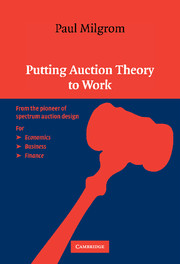Book contents
- Frontmatter
- Contents
- Preface
- Foreword by Evan Kwerel
- PUTTING AUCTION THEORY TO WORK
- 1 Getting to Work
- PART I THE MECHANISM DESIGN APPROACH
- 2 Vickrey–Clarke–Groves Mechanisms
- 3 The Envelope Theorem and Payoff Equivalence
- 4 Bidding Equilibrium and Revenue Differences
- 5 Interdependence of Types and Values
- 6 Auctions in Context
- PART II MULTI-UNIT AUCTIONS
- Bibliography
- Author Index
- Subject Index
- References
6 - Auctions in Context
Published online by Cambridge University Press: 05 June 2012
- Frontmatter
- Contents
- Preface
- Foreword by Evan Kwerel
- PUTTING AUCTION THEORY TO WORK
- 1 Getting to Work
- PART I THE MECHANISM DESIGN APPROACH
- 2 Vickrey–Clarke–Groves Mechanisms
- 3 The Envelope Theorem and Payoff Equivalence
- 4 Bidding Equilibrium and Revenue Differences
- 5 Interdependence of Types and Values
- 6 Auctions in Context
- PART II MULTI-UNIT AUCTIONS
- Bibliography
- Author Index
- Subject Index
- References
Summary
Chapters 2–5 focus on strategies played in the auction and their consequences for economic performance. The auction itself, however, is just one part of a transaction, the success of which depends even more on what happens before and after the auction. Understanding the transaction as a whole requires one to ask who participates and what guarantees quality, delivery, and payment. One must also ask why participants use an auction at all rather than another method of transacting.
To illustrate the challenges of designing procedures for trade, we now discuss two idealized transactions – the sale of an asset and the choice of a supplier.
When an owner sells assets, he must consider what to sell and who might want to buy the assets. If the asset is a commodity frequently traded at an auction site – for example, a major brand of laptop computer sold online at eBay – then the simplest approach may be to list the item for sale at that site. A public auction of this sort reduces the seller's costs of marketing, because the auctioneer supplies most of the required marketing, and maintains a physical or online catalog to help buyers find products they want. The auctioneer's reputation for selling this type of asset helps attract buyers. The availability of similar products at the auction site makes it hard for the seller to get a higher price by conducting his own private auction.
- Type
- Chapter
- Information
- Putting Auction Theory to Work , pp. 208 - 250Publisher: Cambridge University PressPrint publication year: 2004

